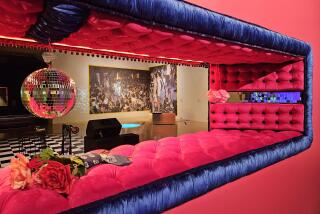ART REVIEW : Carlos Almaraz’s Legacy to Los Angeles
- Share via
Los Angeles artist Carlos Almaraz died of AIDS in 1989 at age 48, leaving behind his wife, Elsa, and a daughter, Maya. He’s buried in the cemetery on the Hawaiian island of Kauai, where he sojourned in late years. The grave is marked with a monument designed by fellow artist Jeffrey Vallance. Almaraz’s epitaph reads, “Here lies a chap quick as a cat and short one life.”
The artist was also a poet with a tough sense of humor.
Now there is an exhibition of his prints and drawings in the newly expanded galleries of UCLA’s Grunwald Center for the Graphic Arts. Titled “Moonlight Theater,” it traces a series of works started in 1982 in collaboration with master printer Efram Wolff. In it you feel life and art stopped short of absolute fulfillment but you feel life’s pulse too. You feel dualities that tugged at Almaraz so hard that at one point the booze got the best of him. You sense the tension between his masculine and feminine sides, the poetic aesthete holding philosophical arguments with the social activist.
In the ‘60s he went to New York, studied Picasso and Beckmann, read Rimbaud and Rilke. In the ‘70s he was politicized by the Chicano movement. He traveled to Cuba and China, studied Diego Rivera and Frida Kahlo. He read Marx, Carlos Fuentes and Octavio Paz. He joined Gilbert Lujan, Roberto de la Rocha and Frank Romero in “Los Four.” Their 1974 exhibition at the County Museum of Art was the first to bring a barrio aesthetic uptown. He collaborated with Luis Valdez in Teatro Campesino and was involved with Cesar Chavez. In 1981, he married Elsa Flores. His career took off. Patrick Ela tells all about it in a sensitive catalogue essay.
It was a colorful and troubled life. This show of 47 sheets could be sentimental but it’s not. It’s scholarly and professional, showing prints in various states and stages and displaying some of the plates.
A couple of the works are sentimental. “Night Theater” tries to use absurdist humor to talk about inner demons. In it, a nude boy and girl gallop offstage on blue ponies, frightened by a guy wearing only a rabbit mask. Like “Rocking Horse,” it shows Almaraz letting the scared kid inside get the best of him.
Almaraz’s social crusading made him a local hero but he’s liable to be best remembered for work that is at once broader and more personal.
His best-known images are freeway crashes and the Echo Park bridge looking Venetian under unlikely palms. Psychologically, they probably express Almaraz’s great duality--the explosive romantic and the pastoral bard.
There is a funk-exotic East L.A. some of us prefer to the slick surface of the West. On summer evenings, heavy air seduces you with the reek of night-blooming jasmine and beer. If you open up the hood of an old car on a night like that, the smell of oil and gas becomes a narcotic uncorking adolescent memory. If things go wrong, it can turn into conflagration on the overpass. Nobody wants that in reality, but in imagination the explosion of fuchsia and lavender fire is as delicious as Delacroix’s “The Death of Sardanapalus.”
Those images are Almaraz’s legacy to the town. They are quintessential L.A.--as crucial in their way as David Hockney’s “Mulholland Drive,” Ed Ruscha’s “Standard Station” or Peter Alexander’s sunsets.
* UCLA, Wight Art Gallery, Grunwald Center for the Graphic Arts, 405 Hilgard Ave. to May 19. Closed Mondays and Tuesdays. (213) 825-3264 .
More to Read
The biggest entertainment stories
Get our big stories about Hollywood, film, television, music, arts, culture and more right in your inbox as soon as they publish.
You may occasionally receive promotional content from the Los Angeles Times.










